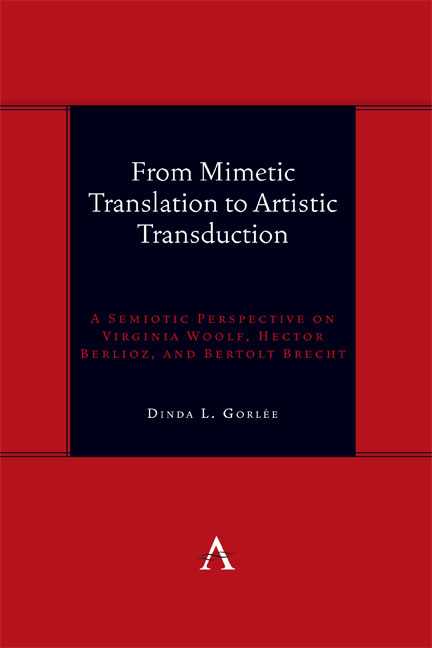 From Mimetic Translation to Artistic Transduction
From Mimetic Translation to Artistic Transduction Book contents
- Frontmatter
- Dedication
- Contents
- 1 Forked Tongues: Theory from Translation to Transduction
- 2 Wave after Wave: Wagner’s Waves Eclipsed by Virginia Woolf
- 3 War and Love: The Parabolic Retranslation in Berlioz’s Opera
- 4 The Threepenny Opera: Jakobson’s Poetics Retranslated in the Spirit of Brecht’s Work-Plays
- Bibliography
- Index
1 - Forked Tongues: Theory from Translation to Transduction
Published online by Cambridge University Press: 01 March 2024
- Frontmatter
- Dedication
- Contents
- 1 Forked Tongues: Theory from Translation to Transduction
- 2 Wave after Wave: Wagner’s Waves Eclipsed by Virginia Woolf
- 3 War and Love: The Parabolic Retranslation in Berlioz’s Opera
- 4 The Threepenny Opera: Jakobson’s Poetics Retranslated in the Spirit of Brecht’s Work-Plays
- Bibliography
- Index
Summary
Exploring New Avenues of Translation
A word of explanation is needed for those readers who have not previously been introduced to the idea of a greater understanding of the evolution of translation into transduction. Transduction is beyond translation: it moves beyond the transferal of one language to another to signify speculative attempts at examining and executing the belief, concepts and meaning of the different arts. The art of translating means engaging in the analytical exercise of transferring, rotating and twisting one language into another art; but for literary translation, the objective of retranslation or self-translation is to create through translation the poetic and lyrical terms of transduction, which is the main concept discussed in this book.
Translation (including retranslation and self-translation) seems to be an ancient and contemporary process of attempting to unite science and art in order to communicate information through incomplete changes and reforms of coded language determined in space or time. In today’s world, an understanding of human culture can expand translation into the unexpected force linguistic retranslation into coded and uncoded music, conveying the “expressive melody, the rhythmic experimentation, the coloristic use of harmony and instrumental timbres, [and] the relaxation of and uncertainty about formal canon” (Longyear 1969, 3). The extension of translation over the ages is called transduction, which concerns the “arts of incompletion” (Bernhart and Englund 2021) of words-and-music as illustrated and exemplified in the present book From Mimetic Translation to Artistic Transduction: A Semiotic Perspective on Virginia Woolf, Hector Berlioz, and Bertolt Brecht.
Transduction expands informational (that is, highly meaningful) language into an inventory of the literary dialects, idioms and jargons of other fine and applied arts. To judge the evolution of translation to transduction, if the operational conclusion arising from the evidence introduced in the examples of this book is a true metaphor, Peirce’s “interpretants” in transduction can signify that the details of the artistic signs are not necessarily seen as harsh and static target units but are sent forth in the fluid patterns given to received source signs. Peirce’s interpretants are called “reactor” signs, explained in terms of the stimuli, responses, needs and satisfaction of the categories of the source sign (Sebeok 1994/1999, 64–65).
- Type
- Chapter
- Information
- From Mimetic Translation to Artistic TransductionA Semiotic Perspective on Virginia Woolf, Hector Berlioz, and Bertolt Brecht, pp. 1 - 46Publisher: Anthem PressPrint publication year: 2023


